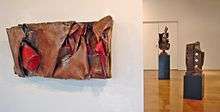Welded sculpture
Welded sculpture (related to visual art and works of art) is an art form in which sculpture is made using welding techniques. The Catalan artist Julio González is credited as one of the earliest developers of welded sculpture.
History

Julio González came from a line of metalsmith workers; his grandfather was a goldsmith in Galicia, the established Catalonian capital in the early 19th century. González's father, Concordio González, owned a workshop and as a young boy, González learned from him the techniques of gold, silver, and iron metalwork. He is associated with the Spanish circle of artists of Montmartre, including Pablo Gargallo, Juan Gris and Max Jacob. In 1918, he developed an interest in the artistic possibilities of welding, after learning the technique whilst working in the Renault Factory at Boulogne-Billancourt. This technique would subsequently become his principal contribution to sculpture, though during this period he also painted and —especially— created jewellery pieces. In 1920 he renewed his acquaintance with Pablo Picasso, for whom he later provided technical assistance in executing sculptures in iron, participating to Picasso's researches on analytic cubism. He also forged the infrastructures of Constantin Brâncuși's plasters. In the winter of 1927-28, he showed Picasso how to use oxy-fuel welding and cutting. When their friendship re-established itself, Picasso and González collaborated on a piece called "Woman in the Garden" between 1928-1930. From October 1928 till 1932, both men worked together. Influenced by Picasso, the fifty-year-old González changed his style, exchanging bronze for iron, and volumes for lines. González began to formalize a new visual language in sculpture that would change the course of his career.[1]

Welding was increasingly used in sculpture from the 1930s as new industrial processes such as arc welding were adapted to aesthetic purposes.[2] Welding techniques, including digital cutting, can be used to cut and join metal. Welded sculptures are sometimes site-specific. Artist Richard Hunt said "The idea of exploiting welding methods and the tensile strength of metals opened up many possibilities to me. This idea was actually linked to the increasing recognition among artists that an art which was representative of our own time ought to use materials and techniques that were at hand, whether it was new experiments using plastics, new kinds of paints, new kinds of surfaces in painting, or using materials developed during the war effort."[3]"
Associated Artists
- Aleš Veselý
- Alexander Calder
- Andrew French
- Anthony Caro
- Antoine Pevsner
- Beverly Pepper
- Bruce Gray
- Charles Ginnever
- David Smith
- James Rosati
- John Raymond Henry
- Julio González
- Ken Macklin
- Kevin Caron
- Lyman Kipp
- Nancy Graves
- Pablo Gargallo
- Pablo Picasso
- Peter Hide
- Peter Reginato
- Revs
- Richard Serra
- Richard Hunt
- Robert H. Hudson
- Robert Willms
- Royden Mills
- Ryan McCourt
- Tim Scott
- TEJN
- Todor Todorov
- Vera Mukhina
External links
Notes and references
- ↑ Le Monde, Julio Gonzalez, la révolution du fer, 4 July 2007 (French)
- ↑ Welded Sculpture of the Twentieth Century, Judy K.Van Wagner Collischan, Lund Humphries, 2000
- ↑ Richard Hunt: Freeing the Human Soul
Further reading
- Creating Welded Sculpture By Nathan Cabot Hale, Courier Dover Publications, 1994
- Welded Sculpture of the Twentieth Century, Judy K.Van Wagner Collischan, Lund Humphries, 2000